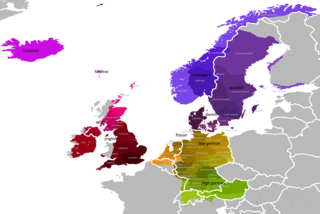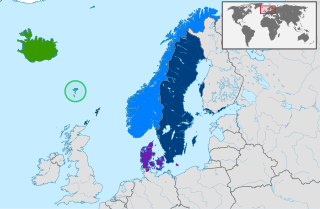Related Research Articles

The Germanic languages are a branch of the Indo-European language family spoken natively by a population of about 515 million people mainly in Europe, North America, Oceania and Southern Africa. The most widely spoken Germanic language, English, is also the world's most widely spoken language with an estimated 2 billion speakers. All Germanic languages are derived from Proto-Germanic, spoken in Iron Age Scandinavia.

The Germanic peoples were historical groups of people that once occupied Northwestern and Central Europe and Scandinavia during antiquity and into the early Middle Ages. Since the 19th century, they have traditionally been defined by the use of ancient and early medieval Germanic languages and are thus equated at least approximately with Germanic-speaking peoples, although different academic disciplines have their own definitions of what makes someone or something "Germanic". The Romans named the area belonging to North-Central Europe in which Germanic peoples lived Germania, stretching East to West between the Vistula and Rhine rivers and north to south from Southern Scandinavia to the upper Danube. In discussions of the Roman period, the Germanic peoples are sometimes referred to as Germani or ancient Germans, although many scholars consider the second term problematic since it suggests identity with present-day Germans. The very concept of "Germanic peoples" has become the subject of controversy among contemporary scholars. Some scholars call for its total abandonment as a modern construct since lumping "Germanic peoples" together implies a common group identity for which there is little evidence. Other scholars have defended the term's continued use and argue that a common Germanic language allows one to speak of "Germanic peoples", regardless of whether these ancient and medieval peoples saw themselves as having a common identity.

Hel is a female being in Norse mythology who is said to preside over an underworld realm of the same name, where she receives a portion of the dead. Hel is attested in the Poetic Edda, compiled in the 13th century from earlier traditional sources, and the Prose Edda, written in the 13th century. In addition, she is mentioned in poems recorded in Heimskringla and Egils saga that date from the 9th and 10th centuries, respectively. An episode in the Latin work Gesta Danorum, written in the 12th century by Saxo Grammaticus, is generally considered to refer to Hel, and Hel may appear on various Migration Period bracteates.

Hel is an afterlife location in Norse mythology and paganism. It is ruled over by a being of the same name, Hel. In late Icelandic sources, varying descriptions of Hel are given and various figures are described as being buried with items that will facilitate their journey to Hel after their death. In the Poetic Edda, Brynhildr's trip to Hel after her death is described and Odin, while alive, also visits Hel upon his horse Sleipnir. In the Prose Edda, Baldr goes to Hel on his death and subsequently Hermóðr uses Sleipnir to attempt to retrieve him.

The North Germanic languages make up one of the three branches of the Germanic languages—a sub-family of the Indo-European languages—along with the West Germanic languages and the extinct East Germanic languages. The language group is also referred to as the Nordic languages, a direct translation of the most common term used among Danish, Faroese, Icelandic, Norwegian, and Swedish scholars and people.

The West Germanic languages constitute the largest of the three branches of the Germanic family of languages. The West Germanic branch is classically subdivided into three branches: Ingvaeonic, which includes English and Frisian, Istvaeonic, which encompasses Dutch and its close relatives, and Irminonic, which includes German and its close relatives and variants.

Proto-Germanic is the reconstructed proto-language of the Germanic branch of the Indo-European languages.

Germania, also called Magna Germania, Germania Libera, or Germanic Barbaricum to distinguish it from the Roman province of the same name, was a historical region in north-central Europe during the Roman era, which was associated by Roman authors with the Germanic peoples. The region stretched roughly from the Middle and Lower Rhine in the west to the Vistula in the east. It also extended as far south as the Upper and Middle Danube and Pannonia, and to the known parts of Scandinavia in the north. Archaeologically, these peoples correspond roughly to the Roman Iron Age of those regions. While apparently dominated by Germanic peoples, Magna Germania was also inhabited by other Indo-European peoples.

A rune is a letter in a set of related alphabets known as runic alphabets native to the Germanic peoples. Runes were used to write Germanic languages before they adopted the Latin alphabet, and for specialised purposes thereafter. In addition to representing a sound value, runes can be used to represent the concepts after which they are named (ideographs). Scholars refer to instances of the latter as Begriffsrunen. The Scandinavian variants are also known as futhark or fuþark ; the Anglo-Saxon variant is futhorc or fuþorc.
Germanic philology is the philological study of the Germanic languages, particularly from a comparative or historical perspective.
German studies is the field of humanities that researches, documents and disseminates German language and literature in both its historic and present forms. Academic departments of German studies often include classes on German culture, German history, and German politics in addition to the language and literature component. Common German names for the field are Germanistik, Deutsche Philologie, and Deutsche Sprachwissenschaft und Literaturwissenschaft. In English, the terms Germanistics or Germanics are sometimes used, but the subject is more often referred to as German studies, German language and literature, or German philology.

Bambecque is a commune in the Nord department in northern France.
Bousbach is a commune in the Moselle department in Grand Est in northeastern France.

Marbaix is a commune in the Nord department in northern France.

Steenbecque is a commune in the Nord department in northern France.
Kleine Schriften is a German phrase often used as a title for a collection of articles and essays written by a single scholar over the course of a career. "Collected Papers" is an English equivalent. These shorter works were usually published previously in various periodicals or in collections of papers written by multiple scholars. A scholar's Kleine Schriften may be contained in a single volume, or several volumes published at once or in series within a period of a few years. Multi-volume collections may contain a scholar's minor or lesser-known book-length works as well.
Piergiuseppe Maritato is an Italian footballer.
Piergiuseppe Vacchelli is the current Adjunct Secretary Emeritus of the Congregation for the Evangelization of Peoples and President of the Pontifical Mission Societies since his retirement was accepted by Pope Benedict XVI on 26 June 2012. He previously served as Under-Secretary of the Italian Episcopal Conference and Chairman of its Charitable Assistance for the Third World.

The name of the Goths is one of the most discussed topics in Germanic philology. It is first recorded by Greco-Roman writers in the 3rd century AD, although names that are probably related appear earlier. Derived from Proto-Germanic *Gutōz ~ *Gutaniz, it is closely related to and probably means the same as the names of both the Geats of southern Sweden and Gutes of Gotland. The implications of these similarities, and the actual meaning of the Gothic name, are disputed in scholarship. Although the Goths have disappeared as a people, their name has survived in various appellations up to the present day.

Creators: The Past is an Italian science fiction fantasy film directed by Piergiuseppe Zaia, who also co-wrote the screenplay with Eleonora Fani and composed the soundtrack. The film stars Eleonora Fani, Jennifer Mischiati, Bruce Payne and Per Fredrik Åsly in the lead roles, and features guest appearances by Gérard Depardieu and William Shatner. The story is about how the destinies of mankind are being manipulated by a race of powerful extraterrestrials known as the Creators. The film was announced as the first part of a planned trilogy, with the next two installments being Creators: The Present and Creators: The Future. Principal photography began in 2014, but the film did not reach theaters before 2020. Its release in Italy eventually suffered from the COVID-19 pandemic.
References
- Patrizia Lendinara, Fabrizio D. Raschellà, Michael Dallapiazza (Ed.): Saggi in onore di Piergiuseppe Scardigli (= Jahrbuch für Internationale Germanistik. Band 105). Lang, Bern etc. 2011, ISBN 978-3-0343-0651-5 (Table of contents)